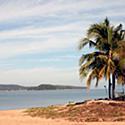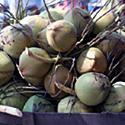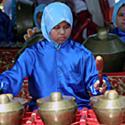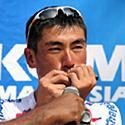
Recently on Cyclingnews.com |
An interview with Tour de Langkawi race director Imran Abdullah, March 17, 2005
Investing in the future
Away from cycling's European heartland, the sport is developing - sometimes rapidly, sometimes more slowly. Tour de Langkawi race director Imran Abdullah is in the vanguard of the move to develop cycling in Malaysia, and the programs he is promoting may provide a basis for the growth of cycling in other countries where the sport has yet to treach its full potential, as he tells Shane Stokes.
 |
For decades Europe has been the power base of cycling, the region where the bulk of the talent, money and events have been based. The so-called 'mondialisation' of the sport seeks to redress this imbalance by promoting cycling in other regions; existing events such as the Tour de Langkawi in Malaysia, the Tour of Qinghai Lake in China and the Tour Down Under in Australia are all flagship events which act as a blueprint for the successful running of big events outside Europe in the future.
The UCI's new Continental calendars are intended to promote the development of such events, as well as bringing more riders, teams and money into the sport. But it is equally important for cycling at this time that growth is promoted at a grassroots level, providing a pathway for the young fan to get involved in the sport and to begin the journey from enthusiastic beginner to experienced pro.
Cyclingnews recently met up with Tour de Langkawi race director Imran Abdullah (aka Simon Donnellan) to look at what measures a country such as Malaysia will adopt over the months and years to come as it aims to become a big cycling nation. Although the talk focussed on this particular Asian country, its 1.HC event and the measures currently being debated to promote the grassroots levels there, the themes covered have a wider significance and relevance to the development of the sport in many other countries. For example, what effect has the introduction of the new Continental calendars had, and how can areas with little heritage of cycling aim to advance things significantly in the future?
Cyclingnews: Over the past while, you have been sitting down with some people to try and work out ways to raise the level of cycling in Malaysia. Can you explain how that has been going?
Imran Abdullah: Well, the Tour de Langkawi has now been running as a successful event for the past ten years. We want to use that as a platform to develop the sport at all levels, from grassroots level upwards, and to raise the calibre of Malaysian cyclists in general. We have spoken to the Ministry of Sport here in Malaysia and we are helping them develop a programme to put cycling into schools and to get it on the radar.
What we have said to them is 'look, we need to privatise this procedure as unfortunately at Federation level in the country, it is not really going anywhere.' So we are putting together some plans to introduce what will be a very simple schools programme, geared towards eight to 15-year-olds. It is primarily based on a similar format to the Go Ride programme that operates in the UK.
CN: Can you talk us through what that involves?
IA: Well, Go Ride is a programme that was initiated by the BCF two or three years ago. It is tailored very much at school level and it doesn't require skilled cycling coaches. It is a series of activities that involve the bicycle which P.E. teachers or anybody with a remote knowledge of cycling can undertake and manage.
It is all centralised by the Internet, in that there is a web site that the kids who participate in it can go visit. They can compare how they are doing with other kids who are involved, and so on. It all leads on to something; it is not like you do this programme and then that is the end of it. Performances are monitored and it acts on several levels. Firstly, it gets the kids involved in cycling and it gets them interested and secondly, it is an excellent monitoring device for scouting talented kids or kids who might want to get into the sport.
Having looked at it and at the success of it, it seems to be a very effective programme. I suppose imitation is the finest form of flattery, but we would sort of 'Malaysianise' a programme similar to that one so that do we get kids onto bikes and into cycling here.
CN: How does it work?
IA: Well, there are some basic exercises... it starts off very simply with the slalom exercises and the bike handling skills, and then there are some races participants can do against their classmates or colleagues, people of a similar age. Basically, once they have completed that programme they are at a level where really they could be ready to join a bicycle club or go to the track or whatever.
CN: So, providing you get the go-ahead, who will run this programme?
IA: Basically, in our plan we have formulated that it will be cross-managed between the Ministry for Sports, the Education Ministry - obviously, because we are talking about schools - and we will get the Malaysian National Cycling Federation involved, but of course it will be funded from the private sector. Therefore there is a little bit of commercialisation of it, very soft. I can't say who the sponsor might be because we have just put the paper up for consideration but, you know, that's how it would be done.
To be honest with you, it doesn't cost a great deal. The real value to it is people's time and resources, not a money factor. That is the nice thing about it.
CN: Overall, how would you sum up the Asian scene at the moment?
IA: I have to say the overall picture at the moment is very promising in that the sport is still at infant level, in terms of its development. I am not just talking about Malaysia, but that cycling as a sport is massively underdeveloped and unstructured in this region. This is one of the reasons why we welcome the UCI's Continental Calendar format because there is now a structure, at least on a national and a professional level. And while there isn't exactly a thriving professional scene going on in Asia, we do have individual teams dotted around the place.
Up until now there was no structured to platform for them to participate on. Now, with this series of 19 events on the calendar - and it looks like it is growing - there is something for both national federations and for the professional teams that are here in Asia, as well as mixing it up with some of the fringe professional teams from overseas. We have them from the States, we have them from Europe, and Australia. It gives them an opportunity to race regularly at a high level. That has been sadly missing up until now. That is very exciting, I think, because it is huge stepping stone towards Asia forming its own pro class and obviously towards building a more established professional scene.
CN: In Asia, if you have a guy or girl of 16, 17, 18 who wants to compete, what options are currently open to them at a club level?
IA: Well, this is the reason why the situation urgently needs addressing, to draw it all together. In Malaysia, for example, there are actually quite a number of events starting to crop up now and cycling is becoming very popular here. It is not even a particular demographic of society, it is right across the board. People are demanding more races because they don't have an outlet to compete. There are social rides, etc, but we are starting to see a merging of the triathlon scene and the cycling scene, whereby they are sharing the events they have to come up with calendar of events. So every weekend, somewhere in the country, there is a race going on.
That said, there is nothing nearly as established as the level there is in Europe. It is still very ad hoc and still very primitive, and there is still no structured calendar as such. So therefore, for your 17-year-old that wants to come into the sport and race, it is very hit and miss because the events are invariably of different levels and different qualities, and again it is not the best way to hone an interest or a talent if you find it here.
CN: I believe there was a good programme of racing held last year in Malaysia?
IA: That's right. Last year there was a series of five events called Racespeda, organised by Malaysians here. Basically, the series allowed anybody with a bicycle and a helmet to come along and race. There were a variety of routes and courses and, on average, it was 90 to 100 kilometres for the open race. We had a huge amount of interest, with people coming from as far as Singapore and Thailand. Cyclists from all over the country came to those series of events. We did have some assistance from the police in terms of road closures and I have to say, at that level it was very well-managed. They've proven to be hugely popular now and there is a demand for more of them, of course. The organisers are busy trying to establish more of these events this year, so it allows people to come along and ride.
CN: What kind of turnout were those events getting?
IA: Roughly between 300 and 400 racing cyclists. They were not just from Malaysia, as I said, they were also from Singapore and Thailand and so on.
CN: Looking at this year's Tour de Langkawi, Koji Fukushima spent a few days in the yellow jersey and generally was on the podium almost the whole race, holding either the race leader's jersey, the mountains jersey or the Asian jersey. Do you think his ride is indicative of a general increase in the level of Asian riders, or is it down to the fact that he and his team-mates race in Europe at times?
IA: I would definitely attribute his success this year to the fact that he has based himself in Europe and because they have a structured programme, if you like. There is no doubt that it was great for us, first and foremost, to have an Asian in the yellow jersey and in Asian stage winner. And the manner in which he did it as well was a great boost for us and we hope it is indicative of years to come. However, we have to acknowledge the reason why he was there, apart from his kamikaze style, was the fact that he is racing regularly in Europe, as are his team-mates, and they have experienced cycling at a high level there.
Without that, for an Asian cyclist to be solely based in Asia, I would rank the chances as being impossible of gaining any form of success in this event because the standard is just too high, unfortunately.
In part two, Imran Abdullah talks about the future of Malaysian cycling, his first year at the helm of Tour de langkawi and the effect of the UCI's changes to the structure of pro cycling.
Photography
For a thumbnail gallery of these images, click here
Images by Shane Stokes
- Australian sprinter Graeme Brown won multiple stages in this year's Telekom Malaysia Tour de Langkawi, taking over the lead in the Asian continental calendar as a result
- The colours of the Malaysian Flag
- Langkawi is known for its stunning beaches
- An unusual cargo at the start of the stage four time trial
- Malaysia offers some spectacular scenery
- The culture is also pretty stimulating for Western visitors
- Koji Fukushima was one of the stars of this year's racing, proving that Asian riders can mix it with the established pros
- Islamic influences are everywhere
- Jose Rujano (Colombia) was probably the smallest rider in this year's field, but also one of the strongest. He finished second overall
- Traditional Malay dress on this dancer, as seen before the start of one of the stages
- Two brothers watch the race as it passes
- Fukushima soaked up the attention of the crowd. He was a dab hand with the harmonica
- Malaysia may not have a long history of bike racing but the enthusiasm of the spectators is unmistakeable
- More young fans - Malaysia's cycling organisations plan to get kids like these off the sidelines and on to bikes.
- Credit Agricole's Geoffrey Lequatre is mobbed by local fans
- The bunch at full speed
- Marlon Perez (Colombia) was one of the animators of this year's race
- Cyclingnews photographer Mark Gunter does his bit to keep up local relations
- You don't see buildings like these at European races!
- The spectators are somewhat different too
- The skyline of Kuala Lumpur is dominated by the Petronas Twin Towers
- The Barloworld team lead race leader Ryan Cox past the Towers
- Ryan Cox dominated this year's race
- Koji Fukushima's mother travelled from Japan to support her son. Of course, he gave Ma a yellow jersey of her own
- The final podium. Graeme Brown took the points jersey, Ryan Cox the yellow and Koji Fukushima was best Asian rider
- Far from the Arctic weather of Europe - the sun sets on a balmy evening in Malaysia













